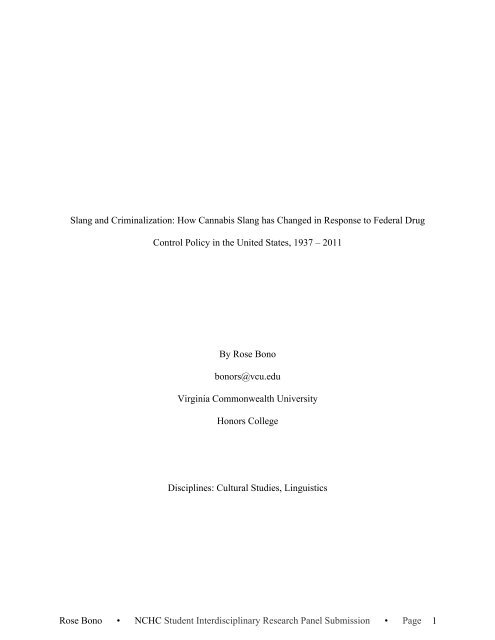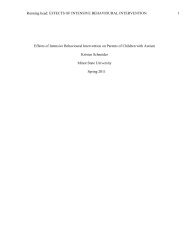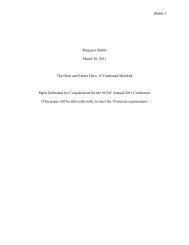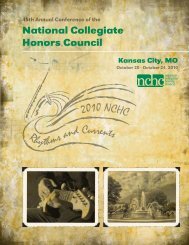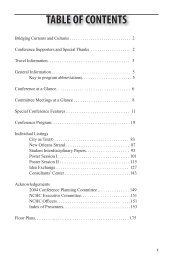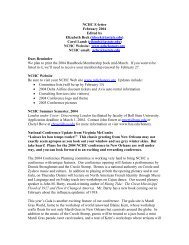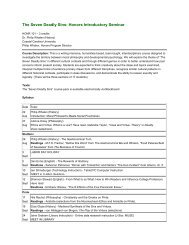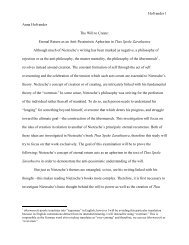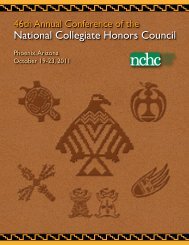Rose Bono SIRP Submission Paper
Rose Bono SIRP Submission Paper
Rose Bono SIRP Submission Paper
You also want an ePaper? Increase the reach of your titles
YUMPU automatically turns print PDFs into web optimized ePapers that Google loves.
Slang and Criminalization: How Cannabis Slang has Changed in Response to Federal Drug<br />
Control Policy in the United States, 1937 – 2011<br />
By <strong>Rose</strong> <strong>Bono</strong><br />
bonors@vcu.edu<br />
Virginia Commonwealth University<br />
Honors College<br />
Disciplines: Cultural Studies, Linguistics<br />
<strong>Rose</strong> <strong>Bono</strong> • NCHC Student Interdisciplinary Research Panel <strong>Submission</strong> • Page 1
Reefer, Mary Jane, grass, chronic. All are names for the same substance, cannabis. Illegal<br />
in the United States since 1937, cannabis has developed its own subculture throughout its<br />
history. Cannabis use, as a reason for and effect of its criminalization, has remained part of a<br />
deviant subculture. This group of cannabis users must, in order to hide their illicit activities, keep<br />
an updated list of code words. These words make up the slang lexicon of marijuana culture. The<br />
lists of words pertaining to the substance marijuana—even disregarding those addressing<br />
associated aspects of the subculture such as volume measurements and paraphernalia—is<br />
endless. However, the most common terms of an era say a lot about the nature of that era. The<br />
way in which slang has changed can be of use to indicate the attitudes of a particular time period<br />
in cultural history. In addition, the changing attitudes related to marijuana use in the United<br />
States are linked to federal policy. The more involved the federal government is with the punitive<br />
measures applied to cannabis, the more the attitudes and, accordingly, the slang relating to<br />
marijuana use changes in response. Much federal policy has focused on certain subcultures and<br />
has linked propaganda to these types of marijuana users; this as well has had an impact on slang.<br />
The way in which marijuana slang changes relates to changes in federal marijuana policy and<br />
general social attitudes surrounding marijuana use.<br />
Slang is an important part of a subculture’s identity and plays a role in the lives of those<br />
involved in said subculture. In this essay, the marijuana-using subcultures in the United States<br />
are examined. While various groups of people have always used marijuana recreationally, each<br />
generation brings on a different idea of what the typical marijuana user says and does. As Bruce<br />
Johnson, Flutura Bardhi, Stephen J Stifaneck and Eloise Dunlap, authors of “Marijuana Argot as<br />
Subculture Threads: Social Constructions by Users in New York City,” state, “marijuana-related<br />
argot provides socially constructed ways of talking, thinking, expressing, communicating and<br />
<strong>Rose</strong> <strong>Bono</strong> • NCHC Student Interdisciplinary Research Panel <strong>Submission</strong> • Page 2
interacting among marijuana users and distributors” (46). The words used for cannabis help to<br />
solidify notions about rituals, expectations, and attitudes surrounding the use and sale of<br />
marijuana. Using marijuana-related terms can create “interaction and communication, connecting<br />
a variety of social groups and networks” (Johnson, et al., 58); this becomes important when an<br />
individual initially establishes oneself as a part of a subculture. Elisa Mattiello, slang researcher<br />
at the University of Pisa, notes in her article "The Pervasiveness of Slang in Standard and Non-<br />
Standard English" that slang can be used to “hide from actual authority” (13) and to “gain<br />
acceptance in a group or to preserve… group solidarity” (13). Slang can be used to bond those<br />
within a similar subcultural group, which explains why slang for marijuana is so prevalent.<br />
Finally, slang helps people to express themselves creatively and in a way that is innovative and<br />
expressive, not to mention specific to a peer group (Mattiello 17). Slang therefore provides an<br />
identity for individuals and groups and promotes subcultural cohesion.<br />
Slang is also used to keep secrets from authority figures. In this way, slang and argot for<br />
marijuana function in the same way. Argot is a set of words designed to keep ideas secret from<br />
those in higher positions of power; argot is code. Slang for marijuana is originally intended to be<br />
argot, as keeping drug use secret is important to drug users. Claims lawyer Joseph Sullivan, in an<br />
article titled “Criminal Slang” printed in a 1921 edition of The Virginia Law Register, “slang had<br />
its birth in criminality” (9). Slang has only come about because of criminal subcultures, in this<br />
case because marijuana use required a high level of secrecy from law enforcement. However,<br />
“most marijuana users did not appear too concerned that non-users might learn their argot” in<br />
field research conducted by Johnson, et al. (58). Much argot—about which few people know—<br />
becomes slang, which is considered more widespread. This means that slang cannot be used to<br />
keep ideas secret for very long; the codes are easily cracked. Therefore, slang must adapt. The<br />
<strong>Rose</strong> <strong>Bono</strong> • NCHC Student Interdisciplinary Research Panel <strong>Submission</strong> • Page 3
slang words surrounding marijuana change relatively frequently to maintain some level of<br />
secrecy as protection against punitive federal policy.<br />
Slang in the 1930s and 1940s<br />
During the late 1930s and into the 1940s, the use of marijuana was demonized by<br />
propaganda and by federal policy. The 1937 Marihuana Tax Act, spearheaded by drug czar<br />
Harry J Anslinger, first made cannabis illegal at the federal level. This act was the result of mass<br />
hysteria about marijuana from a highly successful propaganda campaign. The beginning of<br />
federal marijuana prohibition was closely linked to racial stereotypes against African and<br />
Mexican Americans. The slang that was most common at the time was used primarily by these<br />
subgroups and reflects the fact that they were targeted the most by federal policy.<br />
A prominent subculture during the 1930s and 1940s was the African American jive<br />
culture. This involved urban jazz musicians like Cab Calloway and Sydney Bechet, who played<br />
loud, upbeat music. Jim Crow sentiments were still rampant at this time in United States history<br />
and so this subculture was almost entirely separated from white Americans. This group of people<br />
was often associated with marijuana use. Calloway’s song “Reefer Man” and many other songs<br />
about marijuana from the late 1930s show the relationship between jive culture and marijuana<br />
use. Marijuana slang terms commonly used by this subculture during this era include “jive,”<br />
“mezz,” “muggles,” “reefer,” “vipe,” “tea” and “gage,” along with the longer-lasting “pot” and<br />
“weed.” The words “jive” and “mezz” are associated directly with jive culture. “Mezz” comes<br />
from the name of a concurrent jazz musician named Mezz Mezzrow, who was, incidentally,<br />
white. The word “muggles” was popularized by Louis Armstrong. These terms were the most<br />
common among the prominent marijuana jive culture.<br />
<strong>Rose</strong> <strong>Bono</strong> • NCHC Student Interdisciplinary Research Panel <strong>Submission</strong> • Page 4
Propaganda at this time focused on the evils of cannabis. The iconic movie Reefer<br />
Madness, published in 1936, created a view of marijuana users as deranged. Specific scenes in<br />
the movie, such as the memorable mad piano-playing and hysterical laughter of marijuana users,<br />
directly mock the jive culture, even though the characters are played by white actors. Marijuana<br />
use was often connected to African Americans, who were socially castigated at the time.<br />
According to an article in Cannabis News, an editorial in 1934 claimed that “marihuana<br />
influences Negroes to look at white people in the eye, step on white men’s shadows and look at a<br />
white woman twice” (“Marijuana Tax Act 1938”). Anti-black sentiments at the time were closely<br />
linked with antimarijuana sentiments, creating the image of the crazed marijuana-using African<br />
American.<br />
Another racial subculture seen as heavily invested in marijuana use was Mexican<br />
Americans. This group was highly persecuted by mainstream America and by federal policies<br />
during the 1930s. Because the source of drugs being imported into the United States was slowly<br />
changing from China to Mexico, as pointed out by Braddy Haldeen in his article “Narcotic Argot<br />
Along the Mexican Border” (58), Mexican Americans were closely associated with the<br />
substance. According to Martin Booth, author of Cannabis: A History, in the late 1930s a<br />
proponent of the first marijuana law in Texas said on the floor of the Texas Senate that “all<br />
Mexicans are crazy, and this stuff [marijuana] is what makes them crazy” (169). The connection<br />
between Mexican Americans and marijuana was another reason why marijuana was unpopular in<br />
mainstream and political America in the 1930s. The focus on Mexican Americans in policy is<br />
linked to the word “marijuana.” “Marijuana” was a very common name for cannabis at the time,<br />
both in slang and in the vernacular. According to Larry Sloman, author of Reefer Madness: the<br />
History of Marijuana in America, Harry Anslinger stated that the word marijuana came from the<br />
<strong>Rose</strong> <strong>Bono</strong> • NCHC Student Interdisciplinary Research Panel <strong>Submission</strong> • Page 5
Spanish-Indian root “malihua,” through the use of which Latin Americans “wished to impart the<br />
idea that the substance of the weed seized and took possession and made a prisoner of the person<br />
using the weed” (20). The obviously negative connotation of the word “marijuana” (alternate<br />
spelling “marihuana”) was connected to Mexican American culture. This subgroup was one of<br />
the main targets of many federal marijuana policies. Therefore, the use of the word “marijuana”<br />
was meant, when used in propaganda, to discourage the use of the drug by association with an<br />
undesirable subculture. However, aside from being used in federal policy (as in the “Marihuana<br />
Tax Act”), it was also common slang, especially among Mexican Americans.<br />
During the 1930s and 1940s, when marijuana use was heavily associated with the<br />
‘deviant’ subcultures of African and Mexican Americans, the slang changed with policy. The<br />
shift in the status of cannabis from legal to illegal associated the term “marijuana” with the<br />
socially ‘deviant’ Latin American population, and the propaganda efforts at the time helped to<br />
associate marijuana use with African Americans with words like “reefer” and “jive.” Federal<br />
policy both followed and predicted the changes in marijuana slang.<br />
Slang in the 1950s<br />
During the 1950s, marijuana use continued to be demonized by federal propaganda. The<br />
Vietnam War equated communism, America’s ‘public enemy number 1,’ with cannabis. Soldiers<br />
went off to war and came back much less adamant about the eradication of communism, having<br />
been exposed to marijuana in the jungles of Vietnam. Because this was against the federal<br />
government’s ideological tenets, drug czar Harry Anslinger struck back with a new wave of<br />
propaganda. Films such as “Drug Addiction” and “The Terrible Truth,” published in the 1950s,<br />
continued to emphasize the gateway theory: that marijuana use led to heroin use among<br />
adolescents. This idea, propagated initially during the late 1930s propaganda initiative, was<br />
<strong>Rose</strong> <strong>Bono</strong> • NCHC Student Interdisciplinary Research Panel <strong>Submission</strong> • Page 6
pushed on teenagers in the United States. 1 The films portrayed ‘good children led astray,’ which<br />
reflected the primary social movements of the time. The moralistic nature of the late 1940s and<br />
early 1950s was giving way to Beat culture. This subculture’s loose attitudes regarding sex,<br />
drugs, music, race, and gender were seen as deviant from mainstream American culture. They<br />
were often the target of federal antimarijuana propaganda, albeit indirectly. The continued<br />
antimarijuana campaign included the introduction of mandatory minimums for marijuana<br />
possession, increasing the pressure on marijuana users.<br />
The changing federal focus on marijuana led to changes in slang. One pertinent example<br />
is the word “dope.” While the word’s origins reach back farther than the 1950s, this term became<br />
popular slang during this decade. This is a direct result of the antimarijuana propaganda. Because<br />
the word “dope” has negative connotations, it was used in conjunction with antimarijuana<br />
messages – i.e., the idea that one who smokes marijuana is dumb or that marijuana will make the<br />
user unintelligent. This word proliferated through the propaganda films and posters and reached<br />
the streets, becoming popular slang. Federal policy, including related propaganda initiatives,<br />
shapes street terms directly.<br />
In addition, the common use of marijuana was spreading through racial boundaries<br />
during the early 1950s. Now that African and Mexican Americans were not the sole target of the<br />
propaganda, and with the blossoming of the Beat culture, marijuana use became more<br />
normalized within its using populations. Popular slang terms at the time reflect this. Words for<br />
1 An important aspect of this is the federal classification of marijuana as a narcotic. Throughout<br />
marijuana’s criminalization history, it has been categorized as a narcotic, along with various<br />
opiates and opioids. While under modern scientific classifications, marijuana belongs to the<br />
cannabinoid class of psychoactive drugs, most federal schedules have for a long time listed<br />
cannabis as a narcotic. This classification creates mental nuances linking marijuana and “harder”<br />
drugs like heroin, which are played up in 1930s through 1950s antimarijuana government<br />
propaganda.<br />
<strong>Rose</strong> <strong>Bono</strong> • NCHC Student Interdisciplinary Research Panel <strong>Submission</strong> • Page 7
marijuana such as “tea” and “grass,” which are neosemanticisms (old words with new<br />
meanings), became more commonly used. These words reflect common green plant matter that<br />
mainstream America would not find offensive. This suggests that marijuana use was becoming<br />
more normalized, as the words to describe marijuana were taken from the standard English<br />
lexicon. And, as Johnson, et al., point out, among marijuana users, “verbal communications—<br />
primarily using argot words—provide a powerful mechanism by which they indicate feelings and<br />
emotions resulting from marijuana consumption” (12). Expressiveness is an important reason for<br />
the use of slang. Because common slang terms like “tea” and “grass” come from normal English<br />
words, and because the slang that is used becomes popular for its ability to express the emotions<br />
of the users, the 1950s saw the beginnings of a normalization of marijuana use. Common words<br />
used as slang suggest that marijuana use was becoming more socially acceptable. The social<br />
patterns of marijuana use and acceptance had an effect on marijuana slang. This can be related<br />
back to federal policy in that, while mandatory minimums were being created for marijuana use,<br />
users needed to hide their illicit drug use. In 1951, the Boggs Act increased the penalties for drug<br />
violations and established mandatory minimum sentencing for prison terms (“A History of<br />
Opiate/Opioid Laws”). Five years later, the Narcotics Control Act further increased the punitive<br />
measures of the Boggs Act (“A History of Opiate/Opiod Laws”). During the 1950s, the federal<br />
government was cracking down on marijuana use. Because one of the primary purposes of slang<br />
is to cover up criminal activities, using relatively low-key words like “tea” and “grass” was an<br />
effective method of hiding illicit drug use from a population and government wracked with fear<br />
of “deviant” marijuana users. The social normalization of marijuana among its subcultures and<br />
the increased federal pressure on marijuana users both affected the slang used by everyday<br />
people.<br />
<strong>Rose</strong> <strong>Bono</strong> • NCHC Student Interdisciplinary Research Panel <strong>Submission</strong> • Page 8
Federal propaganda linking marijuana and narcotics—specifically heroin—helped to<br />
change the slang on the streets. Also, increased federal pressure on marijuana users coupled with<br />
an increased social normalization of marijuana use (among those who used it) led to changes in<br />
the slang for marijuana. Both social and political factors play a part in shaping the slang on the<br />
streets.<br />
Slang in the 1960s and 1970s<br />
During the 1960s, the Vietnam War continued to feed government ideology against<br />
communism and, by association, cannabis. However, the youth of the United States changed in<br />
character. Young people began to question authority and to be outspokenly against many of the<br />
long-standing government precedents. The Vietnam War brought protests, along with many<br />
other causes. During the 1960s and 1970s, sociopolitical change was the focus of many college<br />
students. The women’s rights movement, the civil rights movement, antiwar efforts,<br />
environmentalism, and even marijuana activism blossomed during these two decades. The new<br />
social ideals of equality fit the marijuana user perfectly. As Johnson, Bardhi, Stifanek and<br />
Dunlap, write, “the marijuana subculture is structured to promote equality among smokers,<br />
especially in group settings” (11). Subcultural norms among marijuana users reflect overarching<br />
societal trends. Johnson, et al., continue this idea, claiming that “argot terms provide the major<br />
form of social controls and informal sanctions within marijuana-using groups” (12). The<br />
marijuana subculture’s associated language provides etiquette standards for those involved.<br />
Words like “bogart” became popular in the 1960s and 1970s to describe a person who would<br />
take more than his or her ‘fair share’ of the marijuana being equally shared (Johnson, et al. 12).<br />
This notion—that marijuana should be shared equally—fit the overarching societal shift toward<br />
equality, and marijuana use became more socially acceptable during the 1960s and 1970s. This<br />
<strong>Rose</strong> <strong>Bono</strong> • NCHC Student Interdisciplinary Research Panel <strong>Submission</strong> • Page 9
newfound social acceptance of drug use did not only affect the subcultures in which drugs were<br />
used. Non-drug users and drug users alike began to become more comfortable with the idea of<br />
marijuana use. Marijuana activism grew, with the well-known group NORML, the National<br />
Organization for the Reform of Marijuana Laws, being founded in 1970 (norml.org). Marijuana<br />
use was often openly displayed at concerts and festivals, and movies such as Cheech and Chong<br />
in: Up In Smoke and songs such as David Peel’s 1968 “I Like Marijuana” glorified and made<br />
public the use of recreational marijuana.<br />
Federal drug policy during these two decades lessened the federal punishments for<br />
marijuana, generally. The 1970 Comprehensive Drug Abuse Prevention and Control Act<br />
established the scheduling system for all illegal drugs in the United States; it placed marijuana<br />
under Schedule I, the most limiting category, says Kathleen Ferraiolo, professor of political<br />
science at James Madison University, in her article, “From Killer Weed to Popular Medicine.”<br />
This Act also abandoned the mandatory minimums of the 1950s. Drug abuse was the named<br />
target of this new legislation, and so most drug policy aimed to reduce the social problems of<br />
addiction (Ferraiolo 158). During the 1970s, many states and the federal government reduced the<br />
punishment for simple possession of marijuana from a felony to a misdemeanor. Richard Nixon<br />
who, in the early 1970s, declared a “war on drugs,” increased the budgets for both law<br />
enforcement for drug control and for drug abuse treatment and prevention programs (Ferraiolo<br />
159). While drug abuse treatment was the named focus of the legislation passed during this time,<br />
the treatment movement “coexisted alongside an antidrug strategy whose primary emphasis<br />
continued to be law enforcement” (Ferraiolo 159). After Nixon, President Jimmy Carter publicly<br />
endorsed marijuana decriminalization in a message to Congress (Ferraiolo 159). In general<br />
during the 1960s and 1970s, the federal policies surrounding marijuana relaxed the punitive<br />
<strong>Rose</strong> <strong>Bono</strong> • NCHC Student Interdisciplinary Research Panel <strong>Submission</strong> • Page 10
measures of previous eras, with a new focus being drug abuse prevention. Still, however,<br />
Nixon’s War on Drugs increased the federal power and budget for law enforcement.<br />
The growing social acceptance of marijuana use and the changes in federal policy<br />
mirrored a huge change in slang terms. Terms with more positive (and less racial) connotations<br />
became popular. The free attitudes of the hippie culture toward drug use created a culture that<br />
accepted and even praised marijuana. Janis Joplin’s 1965 song “Mary Jane” drew attention to<br />
this: the term “Mary Jane” personifies the substance cannabis and treats it almost like a human.<br />
The new attitudes toward drug use changed the slang so that terms with very positive<br />
connotations and almost personal connections came about in street slang as well. While federal<br />
policies did aim to treat and prevent drug abuse, the amount of federal pressure on marijuana<br />
users did not diminish entirely. The new attacks on domestic outdoor marijuana growing<br />
operations drove the marijuana production underground (quite literally). With marijuana being<br />
grown indoors (as opposed to in soil), the term “hydroponic” became popular slang. This term<br />
applies to any growing operation in which a plant is grown on an artificial substrate, but in the<br />
1970s became popular slang for marijuana because marijuana was commonly grown indoors. 2<br />
This change in street slang was a direct result of federal policy that attacked domestic marijuana<br />
production at the source during the 1970s. In addition, the number and variety of commonly used<br />
slang terms increased dramatically. The terms “reefer,” “dope,” “smoke,” “Mary Jane,”<br />
“hydroponic,” “grass,” “herb,” “weed,” “pot,” “(kind) bud,” “collie,” “ganja,” “skunk” and more<br />
were all very popular during these two decades. The number and variety of these terms reflects<br />
the commonness of marijuana use at the time. Because the War on Drugs and the increased<br />
budget for drug-related law enforcement increased police power, the marijuana-using subculture<br />
2 The variant “dro” from the middle of “hydroponic” was used commonly until the 2000s, when<br />
it was seen to fall out of use to some degree.<br />
<strong>Rose</strong> <strong>Bono</strong> • NCHC Student Interdisciplinary Research Panel <strong>Submission</strong> • Page 11
had to hide their illicit drug use from authorities even more. However, because marijuana was so<br />
widely used and socially acceptable, police could not keep up with the marijuana crimes. The<br />
number and variety of marijuana terms reflect the dual factors of increased police presence and<br />
increased social acceptance by mainstream America. The slang terms serve to hide illicit drug<br />
use from authority figures and simultaneously to creatively express the emotions behind, and<br />
display the commonness of, marijuana use. These seemingly contradictory facets of marijuana<br />
slang demonstrate the combined influence of social and political factors on cannabis-related<br />
slang.<br />
Slang in the 1980s<br />
During the 1980s, slang and federal policy changed again. At this time, marijuana use<br />
was high: according the Office of National Drug Control Policy, in 1979, 35.6% of people aged<br />
eighteen to twenty-five reported having used marijuana in the past month (“Drug Use Trends”). 3<br />
Marijuana-related arrests have increased substantially as well, from about 220,000 in 1970 to<br />
440,000 in 1989 (“Drug Use Trends”). When Ronald Reagan became president, one of his main<br />
foci was the continuation of the War on Drugs. The slight reduction in federal punitive policies<br />
for marijuana under Jimmy Carter did not last long. Reagan’s War on Drugs continued the trend<br />
of federal crackdowns on marijuana and other drugs. His media campaign targeting “crack<br />
whores” popularized the notion that drugs were, again, associated with the “deviant” subculture<br />
of urban African Americans. Ferraiolo reports, “The 1980s witnessed a renationalization of drug<br />
control policy and a renewed emphasis on law enforcement, interdiction, and punishment as the<br />
primary weapons in the war against drugs” (160). Society ranked drug abuse as the number one<br />
problem the nation faced and the growing popularity of cocaine and heroin made drug<br />
3 These numbers have decreased since, to about 16.0% in 2001 among the same age group.<br />
<strong>Rose</strong> <strong>Bono</strong> • NCHC Student Interdisciplinary Research Panel <strong>Submission</strong> • Page 12
enforcement a national priority (Ferraiolo 161). This popularity, along with the growing “rave”<br />
scene using recreational drugs like the newly created ecstasy, scared much of the non-drug-using<br />
mainstream American culture. Any reforms achieved in the 1970s were repealed, and drug<br />
enforcement became a much more militarized affair.<br />
The slang of the 1980s brought little new to the table. Terms “pot” and “weed” continued<br />
to be the most popular, and the term “reefer” was still in use. Additionally, common slang terms<br />
like “Mary Jane” and “dope” were still in use in the 1980s. These terms had staying power, and<br />
were easily accessible to the many people who used marijuana recreationally during the 80s. The<br />
term “dope,” which had not been as popular in the 1960s, came back in popularity in the 70s and<br />
80s due to the increased association of marijuana and heroin in propaganda under the War on<br />
Drugs. The federal pressure on marijuana and other drugs due to Reagan’s policy initiatives did<br />
not stifle marijuana use. Users had to look to new sources for terms to mask the breaking of drug<br />
laws. This explains the increased popularity of the terms “sess,” “sensimilla,” and “kaya.” These<br />
terms come from Jamaican culture, and so did a good job of hiding the subject of their<br />
conversations concerning drug use. Because the 1980s included a huge increase in federal<br />
propaganda against drugs and federal pressure on criminal drug users, the slang at the time was<br />
either preexisting or came from foreign countries.<br />
An interesting side effect of Nixon’s and Reagan’s emphases on drug policy during both<br />
the 1970s and 1980s is the growth in popularity of terms for specific strains of marijuana. The<br />
general increase in federal punitive policies that occurred over both decades drove the marijuana<br />
market even further underground (particularly in the 1980s) and it flourished there. Terms like<br />
“Maui Wowie” and “Acapulco Gold,” although they had been around in slang before, increased<br />
in popularity. The illicit street buyer was provided with higher qualities and more varieties of<br />
<strong>Rose</strong> <strong>Bono</strong> • NCHC Student Interdisciplinary Research Panel <strong>Submission</strong> • Page 13
marijuana because the use rates were high and the law enforcement was stringent. The high<br />
demand for and reduced availability of marijuana during these two decades led to a flowering of<br />
the black market for marijuana to an even greater extent than previous decades had seen. This<br />
coincided with the move of marijuana being grown outside to indoors, where special care was<br />
taken to ensure the highest THC content possible. Because of increased federal focus on<br />
marijuana crimes and increased use rates, the market flourished, bringing with it new slang terms<br />
for specific strains of cannabis.<br />
Slang in the 1990s and 2000s<br />
The 1990s and 2000s brought about a new phenomenon in the marijuana policy debate:<br />
medical marijuana. While the idea of cannabis as medically valid had been around for decades,<br />
the issue was brought to light in the political arena once more in the 1990s. The newly<br />
discovered AIDS virus was quickly gaining status as an epidemic, and new treatments for the<br />
“wasting syndrome” associated with it became necessary (Ferraiolo, 163). This was found in<br />
THC, the main active ingredient in cannabis, which was often seen to induce hunger. Cannabis<br />
was also seen to be useful in treating chemotherapy-related complications and in glaucoma.<br />
Previous activist attempts at legalizing marijuana had not proven successful, and science<br />
continued to suggest the therapeutic qualities of the active ingredient in marijuana, THC.<br />
Kathleen Ferraiolo, political scientist at JMU, asserts that<br />
“with polls showing strong public support for the idea of medical marijuana,<br />
advocates shifted their attention to this more modest proposal and to the statewide<br />
direct democracy process, an institutional venue that allowed them to capitalize<br />
on existing support by framing the issue around sympathetic themes including<br />
patient rights, medical autonomy, and compassion” (162).<br />
<strong>Rose</strong> <strong>Bono</strong> • NCHC Student Interdisciplinary Research Panel <strong>Submission</strong> • Page 14
Medical marijuana softened the public and, more importantly, the lawmakers, on the idea<br />
of some form of legalized cannabis. Ferraiolo continues,<br />
“proponents sought to transform the stereotypical image of marijuana users from<br />
socially marginalized outsiders whose addiction led to objectionable behavior to<br />
ill people who needed the drug to manage their pain. They crafted an alternative<br />
frame of marijuana that emphasized not crime, deviance, and violence, but health,<br />
patient rights, and compassion” (166).<br />
The image of the marijuana user was an important factor in public support for marijuana policy<br />
change, as it had always been a major factor in propaganda initiatives demonizing marijuana.<br />
Thus, medical use of marijuana became more socially acceptable. Gallup polls from 2003 report<br />
that only 34% of Americans believe marijuana should be legalized, but 75% of Americans<br />
support medical marijuana (Lyons). These data suggest that the changing image and aims of the<br />
marijuana user (from recreational to medicinal) has had an effect on public opinion. As of 2011,<br />
sixteen states have passed legislation allowing medical marijuana (McMurray). Under federal<br />
law, medical marijuana is still illegal.<br />
With this change in policy and in public support for marijuana, the language surrounding<br />
the substance has changed as well. Street terms have shifted to reflect the medical marijuana<br />
movement. The term “marijuana” itself has fallen out of use on the street almost entirely.<br />
Johnson, et al., found that field researchers<br />
“almost never hear the word ‘marijuana’ pass through the lips of a marijuana user<br />
or dealer. Many participants equate this word with being a clinical or scientific<br />
term (like cannabis)—one that is used only by the medical world and the law<br />
enforcement world” (7).<br />
<strong>Rose</strong> <strong>Bono</strong> • NCHC Student Interdisciplinary Research Panel <strong>Submission</strong> • Page 15
The word “marijuana,” because of its associations with the medical world and with policy-<br />
related language, has fallen out of use as slang and become standardized within the English<br />
language to a greater degree than before. The term itself has changed from its 1930s era<br />
associations with Mexican American culture to be a term of scientific and legal jargon. This<br />
change in slang is due in large part to policy changes surrounding medical marijuana.<br />
This medical focus on marijuana has had an effect on the common slang that is currently<br />
used. One example of this is the word “chronic.” Becoming popular in the 1990s, this word<br />
usually refers to high quality marijuana available on the streets. The term itself, however, has<br />
medical connotations. “Chronic” can refer to the chronic cough that recreational marijuana<br />
smokers obtain, or to the chronic pain that medical marijuana helps to relieve. The medical<br />
connotations of this term suggest that the shift in cannabis policy toward medical treatment has<br />
had an effect on the slang used on the street. The term “herb” has also stayed in common slang,<br />
as herbalism and alternative medicines continue to gain popularity in the United States. Terms<br />
such as these suggest that policy changes have had effects on street slang for marijuana.<br />
Long-lasting Slang Terms<br />
There are a number of terms which have lasted throughout the decades as common slang<br />
for marijuana. These terms are also usually the most common: “weed” and “pot” have had more<br />
staying power and are more common than most other terms for marijuana. Why is this? Both<br />
“pot” and “weed” have been around for a long time. According to William Safire in his weekly<br />
New York Times article “On Language,” “pot” comes from the Spanish word “potiguaya,”<br />
meaning “marijuana leaves.” This term first appeared in literature in 1938, although was likely to<br />
have been around before that (Safire). “Weed” first referred to tobacco in the 1600s and its first<br />
use in reference to marijuana came in the 1920s, according to Douglas Harper in his Online<br />
<strong>Rose</strong> <strong>Bono</strong> • NCHC Student Interdisciplinary Research Panel <strong>Submission</strong> • Page 16
Etymology Dictionary. These words are among the top two most commonly used words for<br />
marijuana currently. Both are neosemanticisms which share meanings with other common<br />
English nouns. In addition, both are one-syllable words, easy to spell and to speak, and<br />
communicate clearly the buyer or seller’s intentions. Because these words are readily accessible<br />
by much of the population, they remain common. They do not serve the slang functions of hiding<br />
illicit activity, since they are so well-known. They also do not reflect much creativity on the part<br />
of marijuana-using subcultures, as one is merely an abbreviation of an adopted foreign term<br />
(“potiguaya”) and one is borrowed from tobacco smoking (“weed”). However, their accessibility<br />
and simplicity have granted them staying power, contrary to the accepted ideas of slang<br />
proliferation. These words have been affected little by the changing marijuana policies at the<br />
federal level. This suggests that, while policy has a major effect on the types of slang used on the<br />
streets, there are other factors playing into the slang vernacular as well. Policy cannot be the only<br />
factor affecting the changes or lack of changes in slang.<br />
Conclusion<br />
Changes in marijuana policy in the United States have created changes in the types and<br />
varieties of marijuana slang used on the streets. This slang can be used to trace changes in the<br />
social acceptance of marijuana use as well. The future of marijuana slang will depend on the<br />
changes in marijuana policy that will happen within the next few decades. However, it is naïve to<br />
believe that policy is the only factor affecting slang change. Some terms have resisted change in<br />
policy and continue to be popular, and other terms have no visible relation to policy. Such<br />
examples are “ganja” and “kush,” which reflect more the patterns of globalization and cultural<br />
proliferation than the changes in domestic marijuana policy. Future research should address the<br />
multiple causes of slang change, as well as document slang in common street usage. For this<br />
<strong>Rose</strong> <strong>Bono</strong> • NCHC Student Interdisciplinary Research Panel <strong>Submission</strong> • Page 17
study, terms were taken from popular music, books, movies and slang dictionaries. In future<br />
research, collecting interviewers with marijuana users could prove useful in analyzing the street<br />
terms more specifically. Regionalisms must be taken into account as well: while this paper<br />
focused on slang in the United States as a whole, words such as “Cali” (short for “California”)<br />
reflect the regional nature of slang. The United States, being so socially and geographically<br />
diverse, is a large target for slang analysis and this study only provides information about general<br />
trends as opposed to specific trends within defined eras and regions.<br />
<strong>Rose</strong> <strong>Bono</strong> • NCHC Student Interdisciplinary Research Panel <strong>Submission</strong> • Page 18
Works Cited<br />
"A History of Opiate/Opioid Laws in the United States." Buprenorphine - Suboxone -<br />
Buprenorphine Doctors - and Opioid Addiction Resources from The National Alliance of<br />
Advocates for Buprenorphine Treatment. The National Alliance for Advocates of<br />
Buprenorphine Treatment, 20 Apr. 2010. Web. 01 May 2011.<br />
.<br />
Booth, Martin. Cannabis: a History. London: Doubleday, 2003. Print.<br />
Braddy, Haldeen. "Narcotic Argot along the Mexican Border." American Speech. 30.2 (1955):<br />
84-90. Print.<br />
"Drug Use Trends." Drug Policy Information Clearinghouse - Factsheet. Office of National<br />
Drug Control Policy, Oct. 2002. Web. 01 May 2011.<br />
.<br />
Ferraiolo, Kathleen. "From Killer Weed to Popular Medicine: The Evolution of American Drug<br />
Control Policy, 1937-2000." Journal of Policy History 19.2 (2007): 147-79. EBSCOhost.<br />
Web. 2 Mar. 2011.<br />
Harper, Douglas. "Weed." Online Etymology Dictionary. 2001. Web. 1 May 2011.<br />
.<br />
"Introduction - NORML." Marijuana Law Reform - NORML. National Organization for the<br />
Reform of Marijuana Laws, 14 Aug. 2006. Web. 01 May 2011.<br />
.<br />
Johnson, Bruce D., Flutura Bardhi, Stephen J. Stifaneck, and Eloise Dunlap. "Marijuana Argot<br />
As Subculture Threads: Social Constructions by Users in New York City." The British<br />
<strong>Rose</strong> <strong>Bono</strong> • NCHC Student Interdisciplinary Research Panel <strong>Submission</strong> • Page 19
Journal of Criminology 46.1 (2006): 46-77. Oxford Journals. Oxford University Press,<br />
10 June 2005. Web. 12 Feb. 2011.<br />
Joplin, Janis. “Mary Jane.” 1965. MP3.<br />
Lyons, Linda. "Americans Remain Opposed to Legalizing Marijuana." Gallup.Com - Daily<br />
News, Polls, Public Opinion on Government, Politics, Economics, Management. Gallup,<br />
Inc., 3 Dec. 2003. Web. 01 May 2011. .<br />
"Marijuana Tax Act 1938." Cannabis News. 2011. Web. 1 May 2011.<br />
.<br />
Mattiello, Elisa. "The Pervasiveness of Slang in Standard and Non-Standard English." Mots<br />
Palabras Words: Studi Linguistici 6. (2005): 7-41. Web. 6 Feb 2011.<br />
McMurray, Coleen. "Medicinal Marijuana: Is It What the Doctor Ordered?" Gallup.Com - Daily<br />
News, Polls, Public Opinion on Government, Politics, Economics, Management. Gallup,<br />
Inc., 16 Dec. 2003. Web. 01 May 2011. .<br />
Reefer Madness. Dir. Louis Gasnier. Prod. Dwain Esper. Motion Picture Ventures: 1936. DVD.<br />
Safire, William. "The Way We Live Now: 12-22-02: On Language; Going to Pot." New York<br />
Times Magazine 22 012 2002. n. pag. EBSCOhost. Web. 20 Feb 2011.<br />
Sloman, Larry. Reefer Madness: the History of Marijuana in America. Indianapolis: Bobbs-<br />
Merrill, 1979. Print.<br />
Sullivan, Joseph M. "Criminal Slang." The Virginia Law Register 7.1 (1921): 9-17. JSTOR. Web.<br />
8 Mar. 2011.<br />
<strong>Rose</strong> <strong>Bono</strong> • NCHC Student Interdisciplinary Research Panel <strong>Submission</strong> • Page 20
The Terrible Truth. Perf. William B McKesson. Davis Productions, 1951. Web. 1 May 2011.<br />
.<br />
<strong>Rose</strong> <strong>Bono</strong> • NCHC Student Interdisciplinary Research Panel <strong>Submission</strong> • Page 21
Bibliography<br />
"A History of Opiate/Opioid Laws in the United States." Buprenorphine - Suboxone -<br />
Buprenorphine Doctors - and Opioid Addiction Resources from The National Alliance of<br />
Advocates for Buprenorphine Treatment. The National Alliance for Advocates of<br />
Buprenorphine Treatment, 20 Apr. 2010. Web. 01 May 2011.<br />
.<br />
Bechet, Sydney. “Viper Mad.” 1938. MP3.<br />
Black Uhuru. “Sinsemilla.” 1980. MP3.<br />
Booth, Martin. Cannabis: a History. London: Doubleday, 2003. Print.<br />
Braddy, Haldeen. "Narcotic Argot along the Mexican Border." American Speech. 30.2 (1955):<br />
84-90. Print.<br />
Brewer and Shipley. “One Toke Over the Line.” 1971. MP3.<br />
Burroughs, William S. Naked Lunch. New York: Grove Weidenfeld, 1992. Print.<br />
Buster Bailey and His Rhythm Busters. “Light Up.” 1938. MP3.<br />
Calloway, Cab. “The Man from Harlem.” 1932. MP3.<br />
Calloway, Cab. “Reefer Man.” 1932. MP3.<br />
Country Joe and the Fish. “Bass Strings.” 1967. MP3.<br />
Cypress Hill. “Stoned is the Way of the Walk.” 1991. MP3.<br />
Dash Rip Rock. “Let’s Go Smoke Some Pot.” 1995. MP3.<br />
Dazed and Confused. Dir. Richard Linklater. Prod. Richard Linklater. By Richard Linklater.<br />
Perf. Jason London and Jenson Sasha. Gramercy Pictures, 1993. DVD.<br />
Drug Addiction. Perf. John Galvarro and James Brill. Encyclopedia Britannica Films, Inc., 1951.<br />
MPEG4.<br />
<strong>Rose</strong> <strong>Bono</strong> • NCHC Student Interdisciplinary Research Panel <strong>Submission</strong> • Page 22
"Drug Use Trends." Drug Policy Information Clearinghouse - Factsheet. Office of National<br />
Drug Control Policy, Oct. 2002. Web. 01 May 2011.<br />
.<br />
Emmett, David, and Graeme Nice. "Exercise 4: Slang." Understanding Drug Issues : A<br />
Photocopiable Resource Workbook. 2nd ed. Philadelphia: Jessica Kingsley, 2006. 39-52.<br />
Ebrary. Virginia Commonwealth University. Web. 27 Feb. 2011.<br />
Easy Rider. Dir. Dennis Hopper. Prod. Peter Fonda. Perf. Peter Fonda, Dennis Hopper, and Jack<br />
Nicholson. Columbia Pictures, 1969. DVD.<br />
Ferraiolo, Kathleen. "From Killer Weed to Popular Medicine: The Evolution of American Drug<br />
Control Policy, 1937-2000." Journal of Policy History 19.2 (2007): 147-79. EBSCOhost.<br />
Web. 2 Mar. 2011.<br />
Fraternity of Man. “Don’t Bogart Me.” 1969. MP3.<br />
Fritz the Cat. Dir. Ralph Bakshi. By Ralph Bakshi, Ted T. Bemiller, Gene Borghi, Ed Bogas,<br />
Ray Shanklin, and Renn Reynolds. Prod. Steve Krantz. Perf. Skip Hinnant. Cinemation<br />
Industries, 1972. DVD.<br />
Ginsberg, Allen. Howl. Boulder: Museum of American Poetics Publications, 2006. Print.<br />
Goldstein, Rita Z., Dardo Tomasi, Nelly Alia-Klein, Jean H. Carrillo, Thomas Maloney, Patricia<br />
A. Woicik, Ruiliang Wang, Frank Telang, and Nora D. Volkow. "Dopaminergic<br />
Response to Drug Words in Cocaine Addiction." The Journal of Neuroscience 29.18<br />
(2009): 6001-005. EBSCOhost. Virginia Commonwealth University Libraries. Web. 27<br />
Feb. 2011.<br />
Gong. “The Pot-Head Pixies.” 1973. MP3.<br />
<strong>Rose</strong> <strong>Bono</strong> • NCHC Student Interdisciplinary Research Panel <strong>Submission</strong> • Page 23
Haertzen, C. A., F. E. Ross, and N. T. Hooks, Jr. "Slang Knowledge As An Indicator Of A<br />
General Social Deviancy Subcultural Factor." Perceptual and Motor Skills 48 (1979):<br />
1235-240. MEDLINE. Web. 9 Mar. 2011.<br />
Half Baked. Dir. Tamra Davis. Prod. Robert Simonds. By Dave Chappelle and Neal Brennan.<br />
Perf. Dave Chappelle, Guillermo Diaz, Jim Breuer, Harland Williams. Universal Pictures,<br />
1998. DVD.<br />
Harlem Hamfats. “Weed Smoker’s Dream.” 1936. MP3.<br />
Harlem Underground. “Smokin’ Cheeba Cheeba.” 1976. MP3.<br />
Harold & Kumar Go to White Castle. Dir. Danny Leiner, Jon Hurwitz, Hayden Schlossberg,<br />
Todd Schulson, and Hayden Schlossberg. Prod. Greg Shapiro. By Jon Hurwitz. Perf.<br />
John Cho and Kal Penn. New Line Cinema, 2004. DVD.<br />
Harper, Douglas. "Weed." Online Etymology Dictionary. 2001. Web. 1 May 2011.<br />
.<br />
Hyde, James P. "Rat Talk: The Special Vocabulary of Some Teenagers." The English Journal<br />
71.3 (1982): 98-101. JSTOR. Web. 10 Mar. 2011.<br />
"Introduction - NORML." Marijuana Law Reform - NORML. National Organization for the<br />
Reform of Marijuana Laws, 14 Aug. 2006. Web. 01 May 2011.<br />
.<br />
James, Rick. “Mary Jane.” 1978. MP3.<br />
Jazz Gillum. “Reefer Head Woman.” 1938. MP3.<br />
Johnny Guarnieri and Slam Stewart. “Santa’s Secret.” 1944. MP3.<br />
Johnson, Bruce D., Flutura Bardhi, Stephen J. Stifaneck, and Eloise Dunlap. "Marijuana Argot<br />
As Subculture Threads: Social Constructions by Users in New York City." The British<br />
<strong>Rose</strong> <strong>Bono</strong> • NCHC Student Interdisciplinary Research Panel <strong>Submission</strong> • Page 24
Journal of Criminology 46.1 (2006): 46-77. Oxford Journals. Oxford University Press,<br />
10 June 2005. Web. 12 Feb. 2011.<br />
Johnson, Cee Pee. “The G Man Got the T Man.” 1945. MP3.<br />
Joplin, Janis. “Mary Jane.” 1965. MP3.<br />
Julia Lee and her Boyfriends. “Lotus Blossom.” 1947. MP3.<br />
Kerouac, Jack. On the Road. New York, NY: Viking, 2007. Print.<br />
Lerman, Paul. "Argot, Symbolic Deviance and Subcultural Delinquency." American Sociological<br />
Review 32.2 (1967): 209-224. JSTOR. Web. 20 Feb 2011.<br />
Lil Green. “Knocking Myself Out.” 1941. MP3.<br />
Lyons, Linda. "Americans Remain Opposed to Legalizing Marijuana." Gallup.Com - Daily<br />
News, Polls, Public Opinion on Government, Politics, Economics, Management. Gallup,<br />
Inc., 3 Dec. 2003. Web. 01 May 2011. .<br />
"Marijuana | Drug War Facts." Drug War Facts. Common Sense for Drug Policy, 2011. Web. 01<br />
May 2011. .<br />
"Marijuana Tax Act 1938." Cannabis News. 2011. Web. 1 May 2011.<br />
.<br />
Marley, Bob. “Kaya.” 1978. MP3.<br />
Marley, Rita. “One Draw.” 1981. MP3.<br />
Mattiello, Elisa. "The Pervasiveness of Slang in Standard and Non-Standard English." Mots<br />
Palabras Words: Studi Linguistici 6. (2005): 7-41. Web. 6 Feb 2011.<br />
Maurer, D W. "The Argot of the Underworld Narcotic Addict: Part II." American Speech 13.3<br />
(1938): 179-192. JSTOR. Web. 20 Feb 2011.<br />
<strong>Rose</strong> <strong>Bono</strong> • NCHC Student Interdisciplinary Research Panel <strong>Submission</strong> • Page 25
McMurray, Coleen. "Medicinal Marijuana: Is It What the Doctor Ordered?" Gallup.Com - Daily<br />
News, Polls, Public Opinion on Government, Politics, Economics, Management. Gallup,<br />
Inc., 16 Dec. 2003. Web. 01 May 2011. .<br />
Mendez, Elizabeth. "New High of 46% of Americans Support Legalizing Marijuana."<br />
Gallup.Com - Daily News, Polls, Public Opinion on Government, Politics, Economics,<br />
Management. Gallup, Inc., 28 Oct. 2010. Web. 01 May 2011.<br />
.<br />
Muddy Waters. “Champagne and Reefer.” 1981. MP3.<br />
Murray, Thomas E. "The Pragmatic Semantics of Drugs." American Speech. 61.3 (1986): 284-<br />
285.<br />
New Riders of the Purple Sage. “Panama Red.” 1971. MP3.<br />
N.W.A. “Express Yourself.” 1989. MP3.<br />
Paynter, Richard H. "The Language of Drug Addicts." American Speech 4.1 (1928): 19-21.<br />
EBSCOhost. Web. 2 Mar. 2011.<br />
Paxton, Tom. “Talking Vietnam Potluck Blues.” 1968. MP3.<br />
Peel, David. “I Like Marijuana.” 1968. MP3.<br />
Pineapple Express. By Judd Apatow, Shauna Robertson, Seth Rogen, Evan Goldberg, and David<br />
Gordon Green. Perf. Seth Rogen, James Franco, Gary Cole, Rosie Perez, and Danny<br />
McBride. Columbia Pictures, 2008. DVD.<br />
Redman. “How To Roll A Blunt.” 1992. MP3.<br />
Reefer Madness. Dir. Louis Gasnier. Prod. Dwain Esper. Motion Picture Ventures: 1936. DVD.<br />
<strong>Rose</strong> <strong>Bono</strong> • NCHC Student Interdisciplinary Research Panel <strong>Submission</strong> • Page 26
The Devil’s Harvest. Dir. Ray Test. Continental Pictures, Inc.: 1942. DVD.<br />
Robison, Jennifer. "Who Smoked Pot? You May Be Surprised." Gallup.Com - Daily News,<br />
Polls, Public Opinion on Government, Politics, Economics, Management. Gallup, Inc.,<br />
16 July 2002. Web. 01 May 2011. .<br />
Russell, I. W., and Mary G. Porter. "Among the New Words." American Speech 57.4 (1982):<br />
270-76. JSTOR. Web. 1 Mar. 2011.<br />
Saad, Lydia. "U.S. Support for Legalizing Marijuana Reaches New High." Gallup.Com - Daily<br />
News, Polls, Public Opinion on Government, Politics, Economics, Management. Gallup,<br />
Inc., 19 Oct. 2009. Web. 01 May 2011. .<br />
Safire, William. "The Way We Live Now: 12-22-02: On Language; Going to Pot." New York<br />
Times Magazine 22 012 2002. n. pag. EBSCOhost. Web. 20 Feb 2011.<br />
Sharp, Alex. "Oxford Standardizes Slang by Adding New Words to the Dictionary."<br />
Suite101.com. Burda Digital Ventures, 17 Sept. 2010. Web. 8 Mar. 2011.<br />
.<br />
Smith, Bessie. “Gimme a Pigfoot and a Bottle of Beer.” 1933. MP3.<br />
Sloman, Larry. Reefer Madness: the History of Marijuana in America. Indianapolis: Bobbs-<br />
Merrill, 1979. Print.<br />
Snoop Dogg. “Let’s Get Blown.” 2004. MP3.<br />
Steel Pulse. “Macka Spliff.” 1977. MP3.<br />
Steppenwolf. “Don’t Step On the Grass, Sam.” 1968. MP3.<br />
<strong>Rose</strong> <strong>Bono</strong> • NCHC Student Interdisciplinary Research Panel <strong>Submission</strong> • Page 27
Stuff Smith. “Here Comes the Man with the Jive.” 1938. MP3.<br />
Stuff Smith. “If You’re A Viper.” 1936. MP3.<br />
Sullivan, Joseph M. "Criminal Slang." The Virginia Law Register 7.1 (1921): 9-17. JSTOR. Web.<br />
8 Mar. 2011.<br />
The Terrible Truth. Perf. William B McKesson. Davis Productions, 1951. Web. 1 May 2011.<br />
.<br />
Tosh, Peter. “Legalize It.” 1976. MP3.<br />
The Troggs. “Night of the Long Grass.” 1967. MP3.<br />
Washington, Buck. “Save the Roach for Me.” 1944. MP3.<br />
Up in Smoke. Dir. Lou Adler. Perf. Cheech Marin and Thomas Chong. Paramount Pictures,<br />
1978. DVD.<br />
<strong>Rose</strong> <strong>Bono</strong> • NCHC Student Interdisciplinary Research Panel <strong>Submission</strong> • Page 28


